Exclusive deal ending soon: on James Maher’s eBook Essentials of Street Photography
One of the most common mistakes in street photography is to think that it is only about capturing images of people walking down the street. This is a big part of it, of course, but this thought can easily lead to one capturing image after image of slightly interesting people walking down the street. It can stop you from noticing the more subtle cues that can make for a very interesting image in a variety of situations.
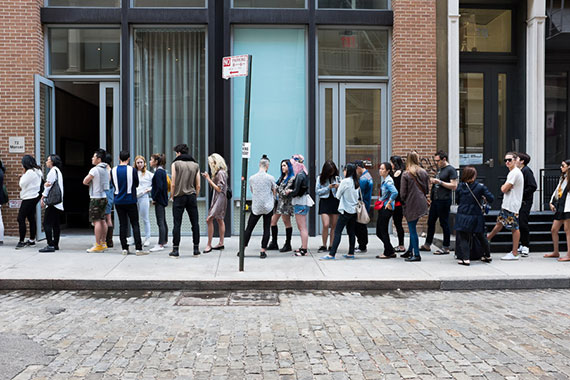
Sample Sale, SoHo, NYC
There is a broad amount of unique content out there that is worth photographing and here are some tips to push you further to find it.
1. Go where nothing is happening
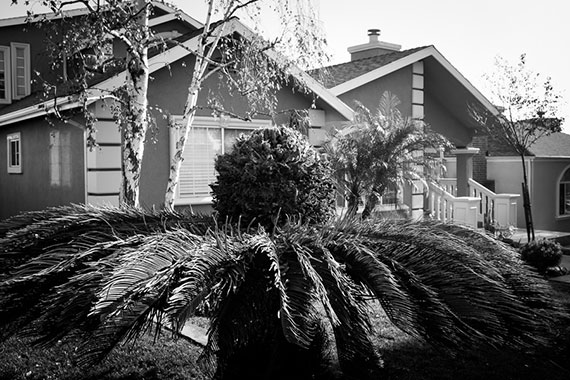
Suburbs, Burbank, California
First of all, one of the best and most common tips for street photography is just to go where the most is happening. Go to busy areas, festivals, fairs, and markets. This is great advice, however, sometimes this advice is given so much that it’s all that people do. When they decide to do some street photography they immediately think about going to the most crowded place.
That does not mean that you shouldn’t also explore places that are much quieter. In fact, the opposite is true. Explore all types of areas to create different types of street images. People do not ever need to be present in the image for it to be a good street image. Create interesting images of culture in a variety of situations and areas.
2. Learn more about the subject matter
The more you know about what you’re shooting, the better your photographs will be. Learn about the cities or neighborhoods that you are shooting in and about the people that inhabit them. Take an interest in your subjects for reasons that go deeper than just how photogenic they look.
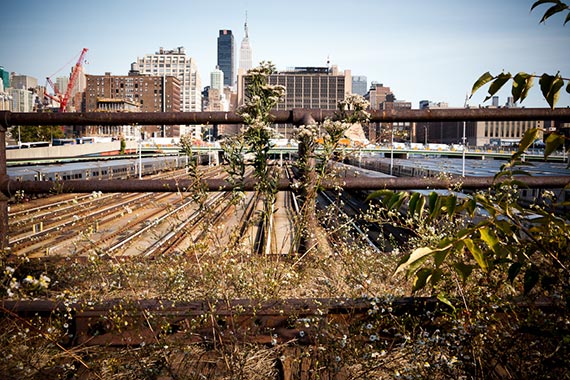
The old High Line
For instance, without knowing much about New York, it is a common thought of visitors that the High Line, the park made from an abandoned elevated train track, is an incredible place that must be visited. When you learn more about it however, it’s shocking to know the truth. When the High Line was first created it was beautiful and there was a ton of light, but most people did not realize that when the plan was approved it came with the rights for developers to build all around, up, and over it. The park has now become the most visited place in New York, but it is not a real park. It is a marketing tool used by developers to raise the land value and to build very valuable high-rises. This public space is not actually for the benefit of the public. It’s packed to the brim with people all bumping into each other and there is so much development that in many places it feels like you’re walking through a subterranean tunnel. There is no longer much directly sunlight in the park either.
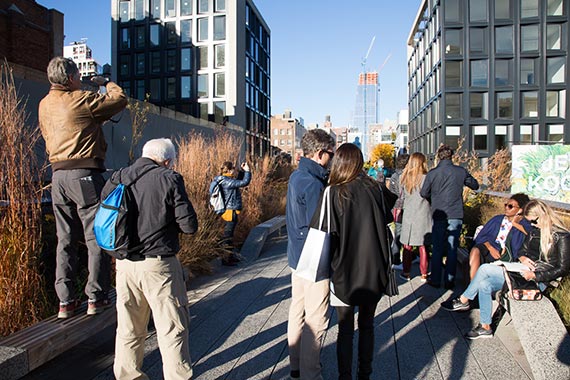
The new High Line
It’s pretty fascinating, isn’t it? If you’re interested in reading more about this subject, see this New York Times article.
Knowing this, wouldn’t this affect how you photographed it? Wouldn’t it help you to create a much more interested and realistic images than if you had just visited with no knowledge at all. It’s actually a fascinating place to photograph, but it is for the reasons that I stated above.
3. Learn about the history of street photography
Take time to learn about and enjoy the history of street photography. Not only is it educational, but it will help give you ideas for your own work and how to develop your eye. Also, it’s fun. If you like shooting street photography, you will probably enjoy looking at it as well. Sitting down with a photo book and some music at night is incredibly relaxing and will get you thinking. Work your way through lists of classic street photographers and classic street photography books and figure out which ones you like and relate to the most. You don’t have to like everything, but give it all a chance. Work your way up to the modern street photographers. There are a lot of them doing great work all over the world and it is so much fun to watch.
4. Learn about yourself
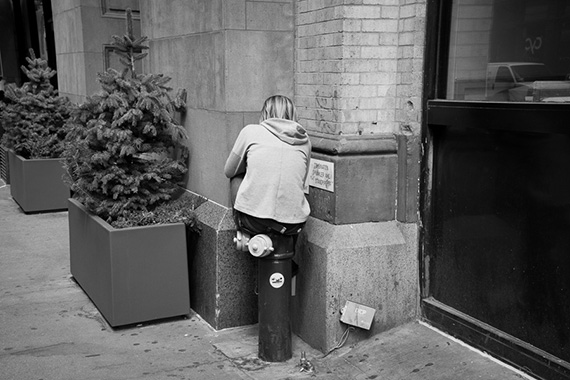
Disconnected, NYC
The interesting thing about street photography is that everything is out there. It’s your job to explore and find it, but at some point you will come across everything. When you look at the work of photographers who have done it for long enough, you can often get a feeling from the images about what the photographer was like. Some photographers prefer happy and funny images, while some prefer them weird or dark. Some photographers are well rounded in their content and some take a very specific type of image.
When I say to learn about yourself, I just mean to pay attention to the images that you like and that you are naturally drawn to when you are out shooting. Combine this with observing how other photographers have done this with your own work and it will help you improve and develop. It will help you foster some ideas within your work as well.
5. Modern as Classic
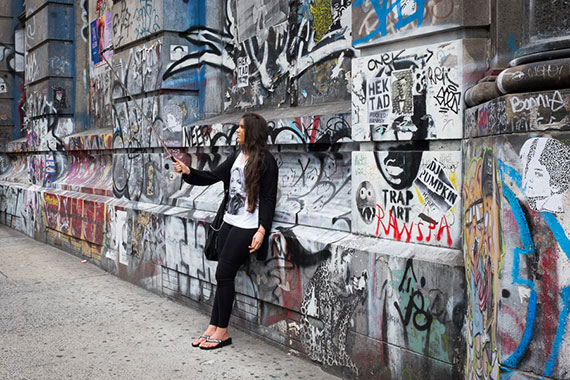
The Bowery, NYC
It’s important to think about how an image is going to change over time. We’re creating beautiful keepsakes from times that are going to change very quickly. Think about what’s going to change and how an image might look after it ages.
Many people try to create images that look exactly like the old masters. Sometimes they will crop out elements that feel too modern to them because of this. But this can be a mistake. Those classic images have already been taken and they have already influenced us; they’ve already been done before. There is a reason you are drawn to take them now. Do you love images with old cars in them but hate images with new cars? Well the new cars are going to look old one day and they will eventually root your images into a place and a time. Think about your biases and the things you take for granted. Try as best you can to pull yourself out of that mindset. The images that are the most modern looking today will feel the most classic looking in the future.
6. An image that not everyone can take
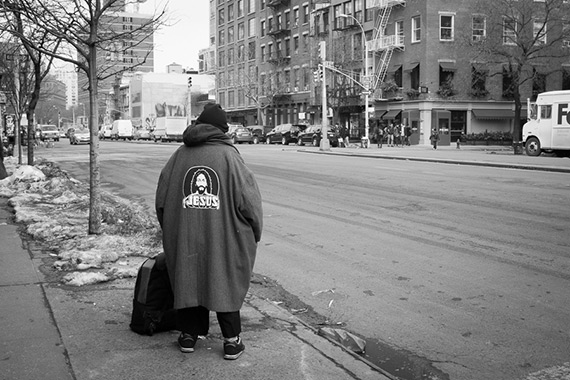
The Bowery, NYC
Everything has been photographed before in some shape or form. While things might look different, history repeats itself. No matter when a photographer shoots, there will be both happy and tragic images.
While you are not obligated to reinvent the wheel every time you take an image, remember that you do have a perspective that is unique to you. Think about the images that everyone tries to take and then think about how you might be able to do it differently. If everyone is pointed in one direction, consider the other direction. This is a very general tip, but it needs to be in the back of your head. When you take an image, try not to think about whether or not other people will like it. That will wait to be seen and as photographers we can be very bad judges about what other people will like. But that’s not important. Take images that you like first and foremost.
7. Create a theme
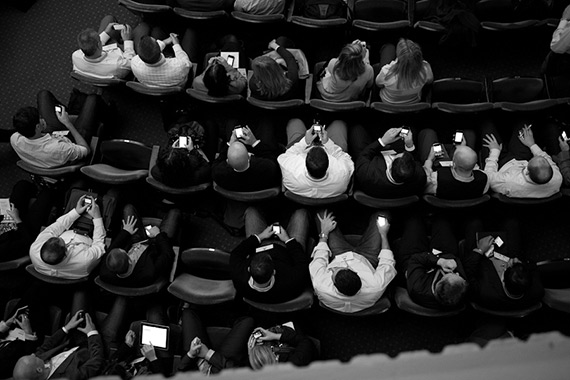
Screens, NYC
After you have shot for enough time, consider working on creating a group of your images that have a similar feel to them. Sometimes you can think about this connection ahead of time, but often you will start to see it evolve the longer you shoot. This is why editing is so important as it helps you to think more about what you are photographing so that you can go out and find images in the future.
Use collections in Lightroom and continuously add to them as you shoot. It’s a very fun process and it can make many of your images take on a new purpose when shown in a sequence of other images.
Bonus Tip: Enjoyment and Not Trying too Hard
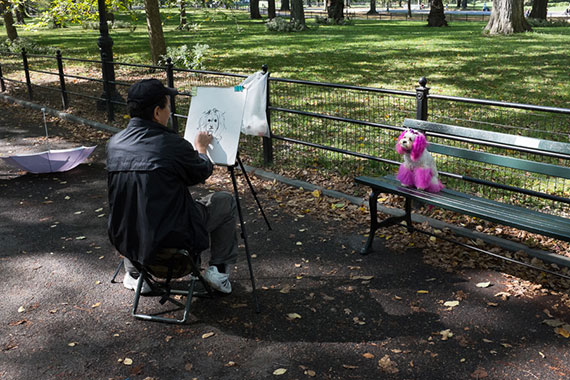
Pink Dog, Central Park, NYC
Take all of this in, study your work and the work of others, and think hard about how to improve your work. However, when you are out there, forget it all and get lost in the moment. The more fun you have and the more you enjoy watching your subjects and walking and exploring, the better you will do. You will want to come back and do it over and over again, which is the real key.
Be spontaneous, take photos that feel right instinctively, and don’t be afraid to take bad or weird images. Take images for yourself. You are going to take a lot of images that are not going to quite work out, but going through the process of taking all those bad images is when the best images will show up. If you’re thinking too hard or not shooting when you feel it because you don’t want to take a bad image, then you’ll miss those spontaneous moments where the best images occur.
For Further Training, Deal Ending Soon:
Author James Maher created an 141 page eBook, Essentials of Street Photography, that covers everything about street photography, even down to specific post processing techniques that can bring the best out of street scenes. We were able to negotiate 25% off for our readers which ends soon. Simply remember to use the discount code PICTURECORRECT at checkout.
Offer found here: Essentials of Street Photography Guide at 25% Off
Go to full article: 7 Tips to Make Your Street Photography More Interesting
What are your thoughts on this article? Join the discussion on Facebook or Google+
Article from: PictureCorrect